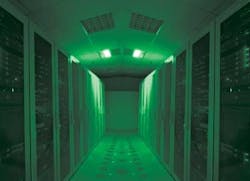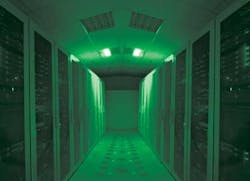Few data centers earn Energy Star label
The Environmental Protection Agency has given just eight facilities the label, citing a lack of full energy-use data from many.
by Patrick McLaughlin
After nearly three years in development the Environmental Protection Agency (EPA) in June 2010 introduced its Energy Star (www.energystar.gov) rating for data center facilities. When announcing the program’s launch, the EPA stated, “Data centers are found in nearly every sector of the economy and deliver vital information technology services, including data storage, communications and internet accessibility. Data centers use a significant amount of energy, accounting for 1.5 percent of total U.S. electricity consumption at a cost of $4.5 billion annually, an amount that is expected to almost double over the next five years.”
To earn the Energy Star label, a data center facility has to be in the top 25 percent of its peers in energy efficiency, according to EPA’s energy performance scale, which is the Power Usage Effectiveness (PUE) metric. The PUE metric was developed by The Green Grid (www.thegreengrid.org) and is calculated by dividing a data center’s total facility power consumption by the power consumed by the information technology (IT) equipment. Using the PUE metric, the closer the number is to 1.0, the more energy-efficient the data center is. (See sidebar.)
Benchmarking energy use
At a Green Grid Technical Forum in March 2011, Michael Zatz, manager of the EPA’s Energy Star program for commercial buildings, provided an update on the first six months of Energy Star for Data Centers. Zatz went over Portfolio Manger (www.energystar.gov/benchmark), the online tool the EPA uses to collect data on buildings, including data centers that are applying for the Energy Star rating. Use of Portfolio Manager is not restricted to facilities making an Energy Star submission; the EPA positions it as a tool that any facility can use to benchmark energy use over time and hopefully improve energy efficiency. “You can’t manage what you don’t measure,” was one point made in the presentation.
How green is your data center? Of more than 600 standalone data centers with energy-use information entered into the EPA’s Portfolio Manager, 8 have achieved the Energy Star rating. The EPA says that many facilities lack 12 months worth of measured IT-equipment energy use.
Zatz reported that energy-use information on more than 600 standalone data centers has been entered into Portfolio Manager, and in all more than 17,000 buildings in the system indicate they have some type of data center. He indicated, however, that of the 600 data centers in the system, only about 125 have provided sufficient information to generate a rating, between 1 and 100, that determines whether or not an Energy Star label is granted. A rating of 75 or greater is required to receive the label. The most-likely issue, Zatz’s presentation explained, is that most facilities have not provided 12 months worth of data. Furthermore, of the 17,000 buildings with some type of data center, only about 400 have entered IT energy measurements.
A few other observations made in Zatz’s presentation are that many individuals entering facility information into Portfolio Manager incorrectly classify spaces like telecommunications rooms as data centers. Also, few operators measure IT energy use, and many are unable to separate IT energy use from the non-IT load. Some users have calculated energy use from spot power measurements, and some are taking measurements at locations other than those required.
Gaining the label
While the number of data centers gaining the Energy Star label may be slow to emerge, the EPA boasts a hefty database of commercial buildings that are using Portfolio Manager to benchmark their energy use and gain the Energy Star label. As of February 21, 2011, a total of 13,162 buildings have earned the label, which account for 2.185 billion square feet. The year 2010 accounted for nearly half the total of both statistics; more than 6,000 labels were awarded that year accounting for more than 1 billion square feet. The EPA awarded approximately 3,900 Energy Star labels to commercial buildings in 2009.
By contrast, as of mid-April 2011, only eight facilities have earned the Energy Star for Data Centers label from the EPA. One of those eight is the 125,000-square-foot Research Triangle Park (RTP), NC data center owned by NetApp (www.netapp.com), which announced its Energy Star accomplishment on July 14, 2010—barely one month after the program kicked off. The facility, which opened in 2009, achieved a score of 99 on the EPA’s 1-100 scale. (See table below of Energy Star-labeled data centers.)
At that time, the EPA’s Jean Lupinacci said, “Improving the energy efficiency of our nation’s buildings is critical to protecting our environment. NetApp is leading the way by earning EPA’s Energy Star for its data center.”
NetApp’s vice president of workplace resources Thom Bryant said, “NetApp is thrilled to accept EPA’s Energy Star in recognition of our RTP data center. It’s a testament to NetApp’s environmental stewardship and commitment to leveraging efficient and sustainable technologies.”
According to NetApp, the RTP data center is primarily used to further research initiatives and create and improve storage efficiency and shared infrastructure technologies for delivering cloud computing and IT-on-demand to help customers accelerate their business. As of July 2010, NetApp said, representatives of more than 500 organizations had toured the RTP data center. “The goal of these tours is to share NetApp best practices and design efforts with customers and noncustomers alike so that the same sustainable and efficient design approach can be applied around the world to help lower overall data center power consumption. In fact, the unique RTP data center design has reduced CO2 emissions for NetApp by approximately 95,000 tons per year, which is equivalent to removing 16,000 cars per year from the road.”
NetApp detailed the steps it took to earn 99 out of 100 points on the Energy Star scale.
- 74-degree Fahrenheit average supply air temperature. Using a higher temperature threshold on supply air allows NetApp to dramatically reduce cooling costs.
- Airside economizer. The data center is cooled by using only outside air 67 percent of the time during the year.
- Pressure-controlled room. Modulating fans, based on NetApp’s proprietary technology, supply pressure-controlled rooms and regulate the volumes of air to avoid oversupplying air and wasting energy.
- Cold-aisle containment. The cold room separates the hot air streams to protect supply air temperatures from being affected by hot air returning from the racks.
- Overhead air distribution. Instead of pumping cold air up through the floors, overhead air distribution takes advantage of cold/hot air buoyancy and eliminates ductwork, reducing the energy needed for fans.
Another labeled facility belongs to BNY Mellon and is located in Freeport, PA. Constructed in 2006 and scoring 86 on the EPA’s scale, the facility announced its Energy Star designation in August 2010. Managing director of BNY Mellon facilities services and sustainability Chip Logan said, “It’s by design that our ongoing sustainability and energy conservation efforts have resulted in this new and significant data center Energy Star designation as we grow our business in an environmentally sustainable way. Together with our partners, we’ve implemented a program of continuous improvement that supports our high standards for energy use and even higher regard for the environment.”
William Stanley, managing director of BNY Mellon’s technology services group, said, “As one of the first few data centers in the registry, this achievement is even more significant. Sustainability and smart business decisions are a good match. We’ve adopted new operating solutions to minimize energy use, reducing the overall carbon footprint of this building that have no impact whatsoever on the company’s critical information technology infrastructure.” BNY Mellon is a member of The Green Grid.
In Zatz’s presentation at the Green Grid Technical Forum, he noted that a June 2011 deadline is looming for facilities that are interested in achieving the label for their facilities. Specifically, efficiency estimates rather than actual measurements will be permitted only until June 2012. Because applications must include 12 months of IT energy data, facilities will have to install meters by June 2011 in order to have a full year of actual measured data by June 2012.
Owner | Location | Square Footage | Numerical rating | Year Constructed |
BNY Mellon | Freeport, PA | 71,000 | 86 | 2006 |
U.S. Department of Energy/ Fermilab Grid Computing Center | Batavia, IL | 16,107 | 76 | 2008 |
HSBC Volo | Volo, IL | 400,000 | 90 | 2007 |
LM Properties/Lockheed Martin EBS | Denver, CO | 62,000 | 81 | 1985 |
NetApp | Research Triangle Park, NC | 125,000 | 99 | 2009 |
Consonus Technologies | West Jordan, UT | 30,512 | 75 | 2001 |
Travelers | Norcross, GA | 155,000 | 75 | 1981 |
Target | Brooklyn Park, MN | 116,000 | 93 | 2001 |
The PUE metric
Power Usage Effectiveness (PUE) is a simple formula that measures complex consumption. That simple formula is total facility power divided by information technology (IT) equipment power. When The Green Grid proposed the use of PUE in early 2007 it also proposed the use of its reciprocal—IT equipment power divided by total facility power, which the organization called Datacenter Efficiency (DCE). The next year, The Green Grid revised the DCE measurement to DCiE, for Datacenter Infrastructure Efficiency. Its calculation is 1 divided by PUE, or IT equipment power divided by total facility power x 100 percent.
By virtue of the calculation, the closer PUE gets to one, the more efficient the data center’s IT equipment is. The EPA collected energy-consumption data from 121 data centers when it initially gathered information for its Energy Star for Data Centers program. The EPA reported those facilities’ PUE ratings ranged from 1.25 to 3.75, with an average rating of 1.91. More than 30 of the participating data centers had PUEs between 1.51 and 1.75; more than 20 rated between 1.76 and 2.0; and between 15 and 20 facilities had a PUE between 2.01 and 2.25.
Patrick McLaughlin is chief editor of Cabling Installation & Maintenance. In this article he reports on a presentation made by the EPA’s Michael Zatz. The information in this report comes from the presentation document Zatz used at the Green Grid Technical Forum in March 2011. That document is available for viewing at www.thegreengrid.org. McLaughlin did not attend the forum.
Past CIM Issues

